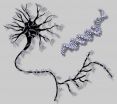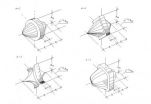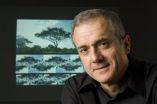(Press-News.org) PASADENA, Calif.—Artificial intelligence has been the inspiration for countless books and movies, as well as the aspiration of countless scientists and engineers. Researchers at the California Institute of Technology (Caltech) have now taken a major step toward creating artificial intelligence—not in a robot or a silicon chip, but in a test tube. The researchers are the first to have made an artificial neural network out of DNA, creating a circuit of interacting molecules that can recall memories based on incomplete patterns, just as a brain can.
"The brain is incredible," says Lulu Qian, a Caltech senior postdoctoral scholar in bioengineering and lead author on the paper describing this work, published in the July 21 issue of the journal Nature. "It allows us to recognize patterns of events, form memories, make decisions, and take actions. So we asked, instead of having a physically connected network of neural cells, can a soup of interacting molecules exhibit brainlike behavior?"
The answer, as the researchers show, is yes.
Consisting of four artificial neurons made from 112 distinct DNA strands, the researchers' neural network plays a mind-reading game in which it tries to identify a mystery scientist. The researchers "trained" the neural network to "know" four scientists, whose identities are each represented by a specific, unique set of answers to four yes-or-no questions, such as whether the scientist was British.
After thinking of a scientist, a human player provides an incomplete subset of answers that partially identifies the scientist. The player then conveys those clues to the network by dropping DNA strands that correspond to those answers into the test tube. Communicating via fluorescent signals, the network then identifies which scientist the player has in mind. Or, the network can "say" that it has insufficient information to pick just one of the scientists in its memory or that the clues contradict what it has remembered. The researchers played this game with the network using 27 different ways of answering the questions (out of 81 total combinations), and it responded correctly each time.
This DNA-based neural network demonstrates the ability to take an incomplete pattern and figure out what it might represent—one of the brain's unique features. "What we are good at is recognizing things," says coauthor Jehoshua "Shuki" Bruck, the Gordon and Betty Moore Professor of Computation and Neural Systems and Electrical Engineering. "We can recognize things based on looking only at a subset of features." The DNA neural network does just that, albeit in a rudimentary way.
Biochemical systems with artificial intelligence—or at least some basic, decision-making capabilities—could have powerful applications in medicine, chemistry, and biological research, the researchers say. In the future, such systems could operate within cells, helping to answer fundamental biological questions or diagnose a disease. Biochemical processes that can intelligently respond to the presence of other molecules could allow engineers to produce increasingly complex chemicals or build new kinds of structures, molecule by molecule.
"Although brainlike behaviors within artificial biochemical systems have been hypothesized for decades," Qian says, "they appeared to be very difficult to realize."
The researchers based their biochemical neural network on a simple model of a neuron, called a linear threshold function. The model neuron receives input signals, multiplies each by a positive or negative weight, and only if the weighted sum of inputs surpass a certain threshold does the neuron fire, producing an output. This model is an oversimplification of real neurons, says paper coauthor Erik Winfree, professor of computer science, computation and neural systems, and bioengineering. Nevertheless, it's a good one. "It has been an extremely productive model for exploring how the collective behavior of many simple computational elements can lead to brainlike behaviors, such as associative recall and pattern completion."
To build the DNA neural network, the researchers used a process called a strand-displacement cascade. Previously, the team developed this technique to create the largest and most complex DNA circuit yet, one that computes square roots.
This method uses single and partially double-stranded DNA molecules. The latter are double helices, one strand of which sticks out like a tail. While floating around in a water solution, a single strand can run into a partially double-stranded one, and if their bases (the letters in the DNA sequence) are complementary, the single strand will grab the double strand's tail and bind, kicking off the other strand of the double helix. The single strand thus acts as an input while the displaced strand acts as an output, which can then interact with other molecules.
Because they can synthesize DNA strands with whatever base sequences they want, the researchers can program these interactions to behave like a network of model neurons. By tuning the concentrations of every DNA strand in the network, the researchers can teach it to remember the unique patterns of yes-or-no answers that belong to each of the four scientists. Unlike with some artificial neural networks that can directly learn from examples, the researchers used computer simulations to determine the molecular concentration levels needed to implant memories into the DNA neural network.
While this proof-of-principle experiment shows the promise of creating DNA-based networks that can—in essence—think, this neural network is limited, the researchers say. The human brain consists of 100 billion neurons, but creating a network with just 40 of these DNA-based neurons—ten times larger than the demonstrated network—would be a challenge, according to the researchers. Furthermore, the system is slow; the test-tube network took eight hours to identify each mystery scientist. The molecules are also used up—unable to detach and pair up with a different strand of DNA—after completing their task, so the game can only be played once. Perhaps in the future, a biochemical neural network could learn to improve its performance after many repeated games, or learn new memories from encountering new situations. Creating biochemical neural networks that operate inside the body—or even just inside a cell on a Petri dish—is also a long way away, since making this technology work in vivo poses an entirely different set of challenges.
Beyond technological challenges, engineering these systems could also provide indirect insight into the evolution of intelligence. "Before the brain evolved, single-celled organisms were also capable of processing information, making decisions, and acting in response to their environment," Qian explains. The source of such complex behaviors must have been a network of molecules floating around in the cell. "Perhaps the highly evolved brain and the limited form of intelligence seen in single cells share a similar computational model that's just programmed in different substrates."
"Our paper can be interpreted as a simple demonstration of neural-computing principles at the molecular and intracellular levels," Bruck adds. "One possible interpretation is that perhaps these principles are universal in biological information processing."
INFORMATION:
View the researchers' videos (part 1, part 2) that explain
their work.
The research described in the Nature paper, "Neural network computation with DNA strand displacement cascades," is supported by a National Science Foundation grant to the Molecular Programming Project and by the Human Frontiers Science Program.
Caltech researchers create the first artificial neural network out of DNA
Molecular soup exhibits brainlike behavior
2011-07-22
ELSE PRESS RELEASES FROM THIS DATE:
As new data wave begins, a gene study in one disease discovers mutations in an unrelated disease
2011-07-22
Often enough, in science as in life, unexpected knowledge has a personal impact. Researchers seeking rare gene variants in just a few individuals with attention-deficit hyperactivity disorder (ADHD) discovered that one patient had a novel combination of two mutations. Those mutations caused a different disease, unrelated to ADHD—a blood disorder called idiopathic hemolytic anemia.
Although the man had long contended with the blood disease, "idiopathic" meant that physicians were unable to determine the cause of his particular anemia—until now, say authors of a new study.
As ...
Animal model sheds light on rare genetic disorder, signaling pathway
2011-07-22
SALT LAKE CITY – A team of researchers from the University of Utah and Brigham Young University has developed a mouse model of focal dermal hypoplasia, a rare human birth defect that causes serious skin abnormalities and other medical problems. This animal model not only provides insight into studying the cause of focal dermal hypoplasia (FDH), but also offers a novel way to study a signaling pathway that is crucial for embryonic development.
The findings were published July 19, 2011, online in the Proceedings of the National Academy of Sciences.
FDH is an uncommon ...
Genetic map of African-Americans to aid study of diseases, human evolution
2011-07-22
JACKSON, Miss. – A group of researchers from the University of Oxford, Harvard Medical School and the University of Mississippi Medical Center has constructed the world's most detailed genetic map, a tool scientists can use to better understand the roots of disease and how DNA is passed generationally to create diversity in the human species.
About 5,000 Jackson-area volunteers were included in a group of nearly 30,000 African-Americans whose genetic information the scientists used to create the map.
The map pinpoints genome locations where people splice together DNA ...
URMC researchers exploring keys to melanoma progression
2011-07-22
Melanoma is devastating on many fronts: rates are rising dramatically among young people, it is deadly if not caught early, and from a biological standpoint, the disease tends to adapt to even the most modern therapies, known as VEGF inhibitors. University of Rochester researchers, however, made an important discovery about proteins that underlie and stimulate the disease, opening the door for a more targeted treatment in the future.
This month in the journal Cancer Research, Lei Xu, Ph.D., assistant professor of Biomedical Genetics at the University of Rochester Medical ...
TGen, Virginia G. Piper Cancer Center studying new breast cancer drug
2011-07-22
SCOTTSDALE, Ariz. — July 20, 2011 — A new drug targeting the PI3K gene in patients with advanced breast cancer shows promising results in an early phase I investigational study conducted at Virginia G. Piper Cancer at Scottsdale Healthcare, according to a presentation by oncologist Dr. Daniel D. Von Hoff at the 47th annual meeting of the American Society of Clinical Oncology (ASCO).
The drug under investigation, GDC-0941, manufactured by Genentech Inc., South San Francisco, Calif., targets the PI3K gene, which is abnormal in about 20-30 percent of patients with advanced ...
Fast prediction of axon behavior
2011-07-22
Researchers at Case Western Reserve University have developed a computer modeling method to accurately predict how a peripheral nerve axon responds to electrical stimuli, slashing the complex work from an inhibitory weeks-long process to just a few seconds.
The method, which enables efficient evaluation of a nerve's response to millions of electrode designs, is an integral step toward building more accurate and capable electrodes to stimulate nerves and thereby enable people with paralysis or amputated limbs better control of movement.
To increase the accuracy of the ...
U of M researchers discover gene required to maintain male sex throughout life
2011-07-22
MINNEAPOLIS / ST. PAUL (July 20, 2011) – University of Minnesota Medical School and College of Biological Sciences researchers have made a key discovery showing that male sex must be maintained throughout life.
The research team, led by Drs. David Zarkower and Vivian Bardwell of the U of M Department of Genetics, Cell Biology and Development, found that removing an important male development gene, called Dmrt1, causes male cells in mouse testis to become female cells.
The findings are published online today in Nature.
In mammals, sex chromosomes (XX in female, XY ...
Research outlines math framework that could help convert 'junk' energy into useful power
2011-07-22
BUFFALO, N.Y. -- A University at Buffalo-led research team has developed a mathematical framework that could one day form the basis of technologies that turn road vibrations, airport runway noise and other "junk" energy into useful power.
The concept all begins with a granular system comprising a chain of equal-sized particles -- spheres, for instance -- that touch one another.
In a paper in Physical Review E this June, UB theoretical physicist Surajit Sen and colleagues describe how altering the shape of grain-to-grain contact areas between the particles dramatically ...
Survey: Killing of bin Laden worsened Americans' views of US Muslims
2011-07-22
COLUMBUS, Ohio – Instead of calming fears, the death of Osama bin Laden actually led more Americans to feel threatened by Muslims living in the United States, according to a new nationwide survey.
In the weeks following the U.S. military campaign that killed bin Laden, the head of the terrorist organization Al Qaeda, American attitudes toward Muslim Americans took a significant negative shift, results showed.
Americans found Muslims living in the United States more threatening after bin Laden's death, positive perceptions of Muslims plummeted, and those surveyed were ...
Seeing the S-curve in everything
2011-07-22
DURHAM, N.C. – Esses are everywhere.
From economic trends, population growth, the spread of cancer, or the adoption of new technology, certain patterns inevitably seem to emerge. A new technology, for example, begins with slow acceptance, followed by explosive growth, only to level off before "hitting the wall."
When plotted on graph, this pattern of growth takes the shape of an "S."
While this S-curve has long been recognized by economists and scientists, a Duke University professor believes that a theory he developed explains the reason for the prevalence of this ...
LAST 30 PRESS RELEASES:
Be careful trusting TikTok for gout advice
A study by the University of Seville links the vanishing of the specific heats at absolute zero with the principle of entropy increase
Anxiety and insomnia may lower natural killer cell count, potentially repressing immune function
How parasitic, asexual plants evolve and live
Research spotlight: A subset of patients with depression could benefit from anti-inflammatory treatment
New fully digital design paves the way for scalable probabilistic computing
Membrane electrode assembly design for high-efficiency anion exchange membrane water electrolysis
U.S. debt ceiling disputes show measurable impact on global crude oil markets
Climate extremes triggered rare coral disease and mass mortality on the Great Barrier Reef
Direct observation reveals “two-in-one” roles of plasma turbulence
Humans rank between meerkats and beavers in monogamy ‘league table’
US fossil reveals early mass-burial event and ancient microbial attack
Sedative choice could improve outcomes for breathing tube patients
New superconducting thin film for quantum computer chips
Simulations reveal protein "dynamin" constricts cell membranes by loosening its grip
Nearly 1 in 5 UK emergency department patients cared for in corridors/waiting rooms
Heavy energy drink intake may pose serious stroke risk, doctors warn
Violence against women and children among top health threats: New global study reveals disease burden far larger than previously estimated
Predicting who is at risk of developing type 1 diabetes, as new drugs now available
New gene-mapping method unlocks hidden drivers of cancer
Ocean current and seabed shape influence warm water circulation under ice shelves
Call to increase funding for ‘invisible’ Deaf victim-survivors of domestic abuse
University of Maryland School of Medicine names distinguished scientist and academic leader Gerald M. Wilson, PhD, as Chair of the Department of Biochemistry and Molecular Biology
Receptors in mammary glands make livestock and humans inviting hosts for avian flu
Icy hot plasmas
Treating adults with autism: Maryland Clinical Center offers national blueprint for care after pediatric transition
University of Phoenix College of Doctoral Studies releases white paper on reclaiming control to build workforce resilience
NCCN Summit seeks to improve care for veterans and first responders with cancer from line-of-duty exposure
ERC Consolidator Grant for soft robotics researcher
Dual-action arts and wellbeing program transforms dementia care
[Press-News.org] Caltech researchers create the first artificial neural network out of DNAMolecular soup exhibits brainlike behavior


